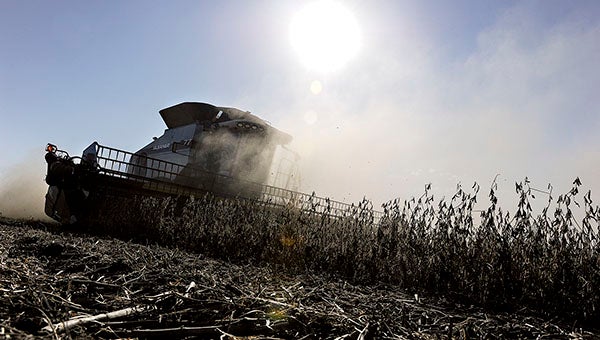Statewide crop harvest better than local, but profits falling
Published 10:52 am Wednesday, October 16, 2013

Roger Toquam harvests a field of soybreans in a field near the family farm northeast of Blooming Prairie last Thursday. — Eric Johnson/photodesk@austindailyherald.com
By Mark Steil
MPR News, 90.1 FM
TYLER, Minn. – A warm fall has helped Minnesota’s $9.5 billion corn and soybean crops.
Some of the state’s farmers are seeing better than expected grain production, among them southwestern Minnesota farmer Alan Roelofs, who has watched his combine gobble up hundreds of corn plants a minute.
On a recent pass through his fields near Tyler, Roelofs glanced at a computer screen mounted in the corner of the cab. One number on the screen was especially noteworthy as it indicates the field should yield about 200 bushels an acre — more than 20 percent above the expected statewide average.
“I would say it’s about the best this field has done,” Roelofs said. “So, I’m really pretty impressed with this.”
Roelofs expects that when he tallies up the harvest from all of his separate corn fields, they’ll average about 180 bushels an acre — still well above the state average.
His soybean fields look like they’ll deliver 53 bushels per acre, also more than in most years. That would be about a third more than the state average according to the latest forecast.
University of Minnesota extension soybean agronomist Seth Naeve said it’s starting to look like the pounding rains of spring built up enough soil moisture to support the crop through the late summer drought.
“This year is one of those years where I expected soybeans to really suffer because the drought was so prolonged,” Naeve said.
But Naeve thinks Minnesota’s final soybean yield will end up being better than originally estimated. Last month the U.S. Department of Agriculture predicted a statewide average of 39 bushels an acre. Naeve said he wouldn’t be surprised if the final figure is several bushels above that.
“The fact that we’re hearing soybean yields [of] 40, 50, 60, 70 bushel yields in some cases, we’re pretty impressed that the plant could do what it seems to have done this year,” he said.
The bountiful harvest is causing grain prices to drop. Corn is 40 percent below last year’s drought-induced peak. Soybean prices have held up better than corn, but have been falling over the past month.
For livestock producers, the trends are a welcome relief after some tough years. They buy a lot of grain to feed their animals and the falling prices will reduce their costs and boost profits. But for grain farmers, slipping prices will shrink profit margins.
“The margins are going to get very tight,” MinnStar Bank farm management analyst Kent Thiesse said.
Thiesse said it now costs farmers more to grow corn than it will fetch when sold. Soybeans are still profitable, but that may not last.
No one’s sounding the alarm yet. Many farmers sold part of their crop on the futures market earlier this year at a profitable price. A good number of farmers carry insurance that pays off when grain prices tumble.
Thiesse said the big farm profits of recent years provide a financial cushion to help get farmers through the downturn.
“I think the biggest concern might be heading into next year,” he said.
That’s because farmers are expected to haul in another bumper crop in 2014. If that happens, grain supplies will grow and prices will fall. That could set off a more pronounced farm financial squeeze than farmers are feeling now.



